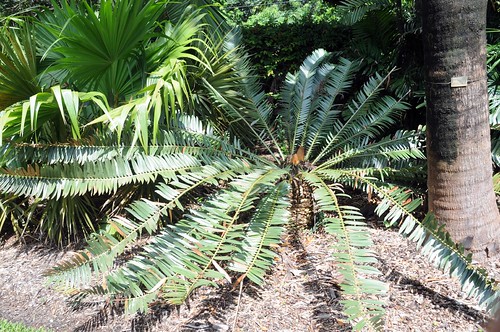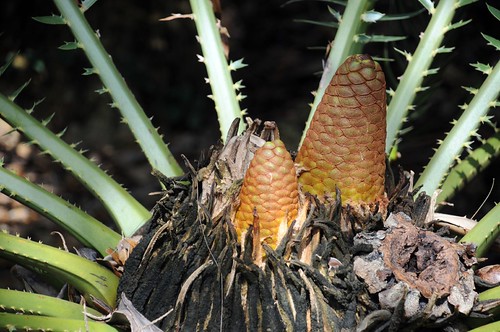Well wow; what a spectacular cycad this was; huge leaves held relatively laxly with those big leaflets in an interesting shade I'd probably describe as sea-green in real life. This is Encephalartos pterogonus.

Why an "extinct cycad" when this is clearly a living plant? Well its not in the wild and nor are any other plants of this species. Originally from Mt Muruwe, Mozambique, it was discovered in 1949, described in 1969, and was extinct in its habitat by 1975, due to poachers....for shame. Its discoverer was a cycad collector called Raymond Munch and it was in Munch's garden as opposed to the wild that the material for the species' scientific description was collected in '69 by Robert Allen Dyer. If you're wondering about the name; pterogonus derives from pteron (wing - as in pterosaur) and gonas (seed) and refers to the distinctive wing-like and toothed appendages below the terminal facet of the microsporophylls." I can tell you that because of this awesome document, an absolute gem for the true botany nerd.

A close up of the crown reveals a pair of beautiful young male cones beginning to emerge. Nice. This illustrates one of the reasons I'm relatively upbeat about this species' future. We know the identity of a number of the original plants and can produce unquestionably "true" E. pterogonus seedlings in captivity. We also know the type locality of the original colony so if the issue of poaching can be controlled I see no reason why some time in the future the species can't be restored. Perhaps by the time I'm an old man we'll be ready.
2 comments:
So I take it there are females somewhere? Are they also in his garden?
Beautiful cycad -- and nice story. Thanks, Tai.
That's right Sally - this one (unlike woodii and relictus) has both sexes extant and in captivity. I only saw the one specimen at the garden I took these shots at and I don't know if the original collection contains both sexes but its certainly around in BGs in breedable format.
Post a Comment